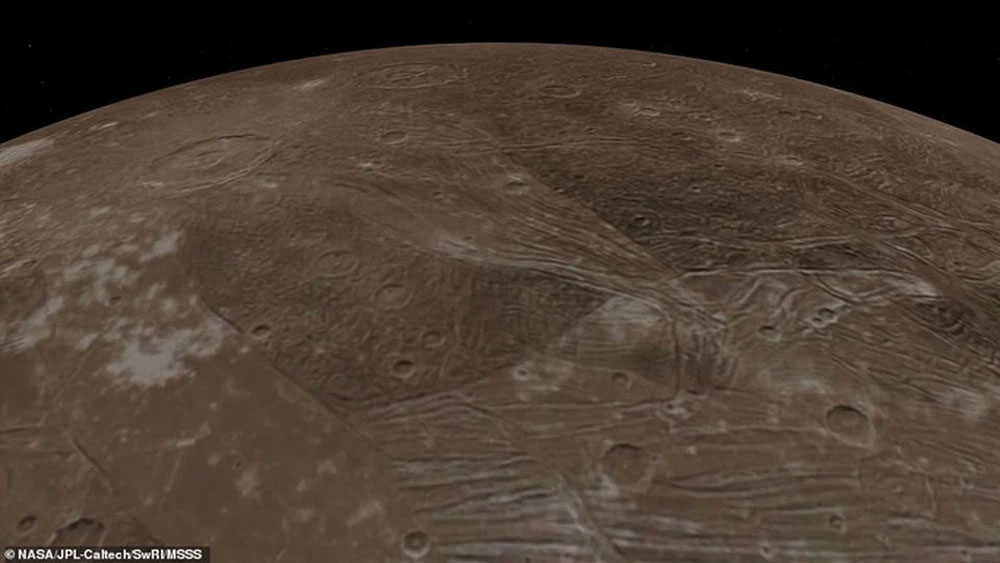Stunning photos of the largest moon in the Solar System
Some photos capture the highlights and shadows of Ganymede. According to scientists, these areas are the result of the process of ice converting into water vapor. Others show Tros, one of the largest and brightest craters on Ganymede.

Ganymede - the largest moon in the Solar System - was taken on June 7. Photo: NASA


Ganymede's bright and dark areas. Photo: NASA.
With the image of Jupiter released by NASA, viewers can also see the tornadoes on the planet's surface and the "string of pearls" - including 8 large storms that appear as a retroverted white oval. clockwise. Valuable information from these images helps scientists better understand Ganymede - formed about 4.5 billion years ago, at the same time as Jupiter and is the only moon with its own magnetic field, creating a polar pole. optical.

Ganymede was formed around the same time as Jupiter, about 4.5 billion years ago. Photo: NASA.

Image above the surface of Jupiter. Photo: NASA.

Juno captures tornadoes on Jupiter's surface. Photo: NASA

The 8 major storms that rotate counterclockwise appear as white ovals. Photo: NASA
Juno - worth $ 1.1 billion, started its journey to Jupiter on August 4, 2011, and after five years it reached its destination on July 4, 2016. Juno's mission is to understand the origin and evolution of Jupiter, map the magnetic field, search for solid planetary cores, measure water and ammonia in the deep atmosphere, and observe the aurora borealis.
You should read it
- 2 more moons found around Jupiter
- Jupiter's atmosphere has more water than we think
- The distance from Earth to Jupiter - what is the largest planet of the solar system?
- Bacteria on Earth live easily on Moon Enceladus
- Full Moon facts - Full moon you may not know yet
- Discover incredible facts about the Moon
- The moon has a life expectancy of about 4.51 billion years - bigger than we think and so does life
- This is why we always see the Moon always following us
- Synthesize high resolution moon wallpaper on computer
- 50 images of Saturn's Enceladus moon - where life can exist (Part 1)
- Did you know: Mars, Venus has rotten egg smell and the Moon smells of gunpowder
- Listen to the strange sound obtained from planets in the Solar System
May be interested

Unusually large amount of methane detected on Saturn's moon: Is it alien life?

For the first time, NASA successfully built a 3D map of the heliosphere, the 'giant bubble' is protecting the Earth

Astrophysics professor teaches how to jump into a black hole so it's 'safe' and possible events

There will be the last super moon of 2021 at dawn on June 25

Traveling interstellar, the Voyager 1 spacecraft sent back to Earth strange sounds

Discovered mysterious signals emanating from a star right next to the Solar System, possibly of aliens






 The moon has a life expectancy of about 4.51 billion years - bigger than we think and so does life
The moon has a life expectancy of about 4.51 billion years - bigger than we think and so does life NASA announces a place that can survive life right in our solar system
NASA announces a place that can survive life right in our solar system Bacteria on Earth live easily on Moon Enceladus
Bacteria on Earth live easily on Moon Enceladus Explore the moon and extremely detailed planets with new features on Google Maps
Explore the moon and extremely detailed planets with new features on Google Maps The world's largest underwater cave system is found on the Yucatan Peninsula
The world's largest underwater cave system is found on the Yucatan Peninsula Find the right place for humans to migrate more than Mars, and it is in the solar system
Find the right place for humans to migrate more than Mars, and it is in the solar system